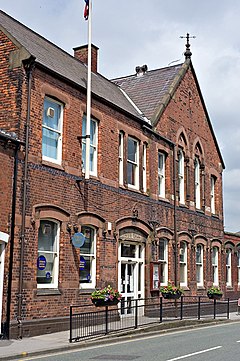Ashton-in-Makerfield
| Ashton-in-Makerfield | |
|---|---|
 Ashton-in-Makerfield Town Hall |
|
| Ashton-in-Makerfield shown within Greater Manchester | |
| Population | 24,000 |
| OS grid reference | SJ574992 |
| • London | 173 mi (278 km) SE |
| Metropolitan borough | |
| Metropolitan county | |
| Region | |
| Country | England |
| Sovereign state | United Kingdom |
| Post town | WIGAN |
| Postcode district | WN4 |
| Dialling code | 01942 |
| Police | Greater Manchester |
| Fire | Greater Manchester |
| Ambulance | North West |
| EU Parliament | North West England |
| UK Parliament | |
Ashton-in-Makerfield is a town located in Greater Manchester, England. Part of the Metropolitan Borough of Wigan it is 4.2 miles (6.8 km) south of the town of Wigan. In 2001 it had a population of 28,505, increasing to 28,762 at the 2011 Census.
Historically a part of Lancashire, Ashton-in-Makerfield was anciently a township in the parish of Newton-in-Makerfield (as Newton-le-Willows was once known), Winwick and hundred of West Derby. With neighbouring Haydock, Ashton-in-Makerfield was a chapelry, but the two were split in 1845. The place has long been a centre for the manufacture of locks and hinges, but also sits on the Lancashire Coalfield, and so was a coal mining district.
The name Ashton derives from Old English and means the "farmstead where the ash-trees grow"; it is a common name and is found locally in Ashton-under-Lyne in Tameside and Ashton upon Mersey in Trafford. The town's name was recorded as Eston in 1212. Later, the suffix "in-Makerfield" was added, which relates the name of the old district of Makerfield of which Ashton was a part; Makerfield derives from the Celtic for a wall or ruin and the Old English word feld, meaning "open land".
St Thomas' Church of England parish church on Warrington Road has ancient origins although the present building is barely over 120 years old. The graveyard is the resting place of many of the 189 victims of the Wood Pit explosion (at Haydock on Friday 7 June 1878), the worst coal-mining disaster in Lancashire at the time.
...
Wikipedia

